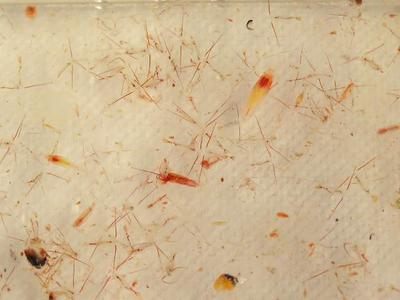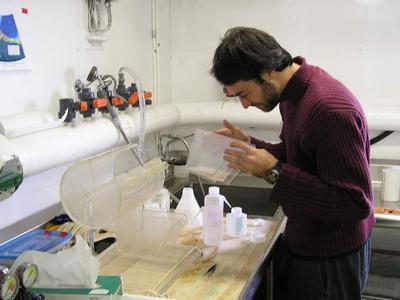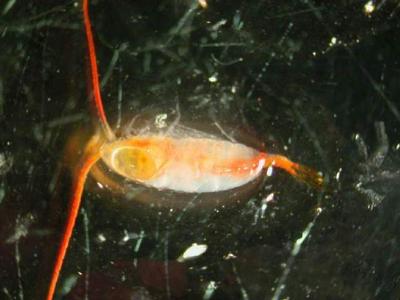
|
|
21 July, 2003
Every so often there is another kind of "cast" that we make from the
Palmer. Whereas our CTD/rosette casts capture data and water, a
Bongo cast catches bugs. That's right, creatures from the deep. You
never know what might come up with each cast of the Bongo net:
Shrimp, jellyfish, gastropods, ostricods, amphipods, worms, fish
larvae, and many other kinds of zooplankton.
The bug of greatest interest, however, to researcher Leopoldo Llinas
is the copepod. Leopoldo is a graduate student from the University
of Miami who is studying these fascinating creatures under the
direction of Dr. Sharon Smith. In fact, this is Leo's second cruise
to study copepods in the Arctic, and he even plans to go again next
year so that he will have 3 years of data to work with for his PhD
dissertation. Leopoldo's enthusiasm for these diminutive bugs is
highly contagious for it took only a few minutes in listening to him
talk about his work for me to be completely swept-up in his project.
The first thing that you'll learn from Leopoldo about the copepods
that he is finding on our voyage is that they are BIG! Calanus
hyperboreus is, by copepod standards, a whopper- up to five huge
millimeters in size. Most copepods are tiny, or even microscopic,
but C. hyperboreus is readily visible to the naked eye. A
close inspection reveals a crystalline-like creature with two long,
red-colored antennae that stand-out from the transparent body with a
golden gut down its middle, and a little more red on what must be its
tail.
Another thing about copepods: they are not all the same. C.
hyperboreus is abundant in the coldest waters, while
Pseudocalanus is more common at slightly warmer temperatures.
Calanus glacialis is somewhat intermediate between the two. In
all, there are at least 20 species of copepods that Leopoldo is
studying. Complicating Leo's task even further are the babies, or in
scientific terms, the "nauplia." In fact, C. hyperboreus are
surprisingly long-lived. From nauplia to adult, this large copepod
may live up to two years. To survive the long harsh winter when the
sea is frozen-over, these amazing creatures hibernate (called
diapause) just like a bear, although they do it at 1000 meters below
the surface instead of in a cozy den.
And copepods eat phytoplankton. This is important because these
photosynthetic plankton capture the sun's energy which is passed on
to the copepods every time they dine on one of these plant-like
critters. Put another way, copepods are the cattle of the sea,
continuously grazing on the marine "phyto-grass" that we are
rounding-up with each cast of the Bongo net. Together, the
phytoplankton and the zooplankton - including the copepods - form the
base of the food chain that everything from jellyfish and whales to
seals and polar bears, depends on to live.
Right now, Leo is focusing on collecting as many samples as he can,
but it seems to me that his real work will begin when he returns to
his lab at the university. There he'll use molecular techniques that
involve extracting DNA from an individual copepod- including those
tiny nauplia babies- that will help him identify various species of
copepods, and to determine the distributions of different populations.
But there's even more. An interesting aspect of Leopoldo's project
involves comparing today's research to data collected in the 1950s in
these very same waters. Indeed, since certain species of copepods
are distributed in distinct kinds of salinities and temperatures of
sea-water, they can be used as a sort of tracer, or bioindicator of
the ecosystem. It is yet another type of data that may allow
scientist to assess the extent of environmental change as we try to
better understand global warming.
I don't know about you, but thanks to Leopoldo, I can't wait to see
what he brings up in the next cast of the Bongo net.

Leopoldo Llinas and Jenny White conduct a Bongo net cast.

A copepod stew with a larger shrimp and amphipod or two.

Leopoldo inspecting his latest catch of copepods.

Calanus hyperboreus.

Calanus glacialis.

Pseudocalanus.
Contact the TEA in the field at
.
If you cannot connect through your browser, copy the
TEA's e-mail address in the "To:" line of
your favorite e-mail package.
|
